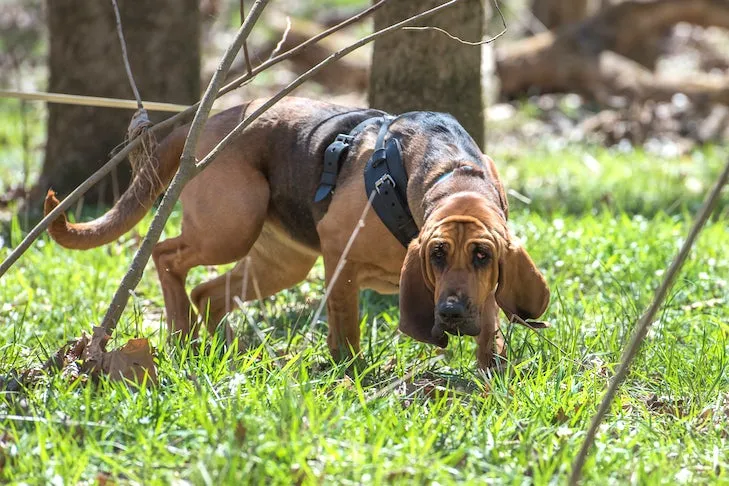Mushrooms are a complex and intriguing food group. These edible fungi are culinary staples in countless dishes and sprout abundantly in our natural environments, yet stories of mushroom foraging gone awry are common. For dog owners, a critical question arises: can dogs eat mushrooms safely? The definitive answer hinges entirely on the specific type of mushroom in question.
Wild Mushrooms: A Serious Threat to Dogs
Imagine strolling through a wooded trail with your canine companion, who is enthusiastically exploring the ground with their nose. Suddenly, they stop to ingest something. Upon investigation, you discover your dog has consumed a wild mushroom. A feeling of panic in this scenario is entirely justified.
There’s a common misconception that dogs can instinctively avoid toxic mushrooms due to their scent. Unfortunately, this is not true. Veterinary experts and mycologists warn that wild mushroom poisoning is often an under-reported cause of fatal poisoning in dogs. Swift action following a suspected wild mushroom ingestion is paramount for your dog’s safety and well-being. If you suspect your dog has eaten a wild mushroom, contact your veterinarian, an animal poison control center, or an emergency veterinary hospital without delay.
Why Dogs are Attracted to Wild Fungi
Dogs perceive the world primarily through scent and taste, and the unique texture of a mushroom can also pique the interest of an inquisitive canine. Compounding the risk, certain varieties of highly toxic mushrooms, such as Amanita phalloides (death cap) and Inocybe species, emit a distinct fishy odor. As many dog owners can attest, dogs find fishy smells particularly appealing, which regrettably explains why pets frequently ingest these dangerous mushroom species.
 Bloodhound on a scent in the woods
Bloodhound on a scent in the woods
Unless you possess expert mycological knowledge, veterinarians strongly advise against attempting to identify the mushroom yourself. Instead, they urge pet owners to seek immediate veterinary treatment, as even experienced mushroom foragers can make critical identification errors.
Common Toxic Wild Mushroom Species to Watch Out For
While only a small percentage of the world’s mushroom species are toxic, those that are can be extremely dangerous, even fatal. Distinguishing between toxic and non-toxic varieties is incredibly difficult for the untrained eye. Therefore, veterinarians uniformly recommend treating all wild mushrooms as potentially toxic and any ingestion as a veterinary emergency. Some of the most problematic wild mushrooms for dogs include:
- Amanita phalloides, widely known as the “death cap”
- Galerina marginata, also called “deadly Galerina” or “Galerina autumnalis”
- Amanita gemmata, often referred to as the “jeweled deathcap”
- Amanita muscaria, known as “fly agaric” or “Deadly Agaric”
- Gyromitra species, or false morel
- Inocybe species and Clitocybe dealbata mushrooms
Recognizing the Symptoms of Mushroom Poisoning in Dogs
The clinical signs of mushroom poisoning in dogs vary significantly depending on the mushroom species ingested. Different mushroom species contain distinct toxins that affect canine physiology in diverse ways.
For instance, Amanita mushrooms contain potent amanitin toxins. These typically induce severe gastrointestinal symptoms, followed by a misleading period of apparent recovery where the dog seems to improve, only to then suffer from acute liver failure, kidney injury, and ultimately, death. Other types of Amanita mushrooms can lead to sedation, tremors, an uncoordinated gait (ataxia), and seizures.
Inocybe species and Clitocybe dealbata mushrooms commonly cause symptoms such as excessive salivation, watery eyes, increased urination, diarrhea, and various neurological disturbances. The false morel, while causing profuse vomiting and diarrhea, is generally not considered fatal.
Many other mushroom types can simply cause general gastrointestinal upset. While these are rarely life-threatening, it can be extremely challenging to determine the specific type of mushroom ingested based solely on early symptoms. Sometimes, we aren’t even aware our dogs have eaten mushrooms. Here is a comprehensive list of common symptoms associated with mushroom poisoning in dogs:
- Vomiting
- Diarrhea
- Excessive salivation
- Weakness
- Lethargy
- Ataxia (staggering gait or loss of coordination)
- Coma
- Seizures
- Liver failure
- Jaundice (yellowing of skin and eyes)
- Abdominal pain
- Death
The severity of toxic effects from mushrooms can also be influenced by any underlying health conditions your dog may have or by the simultaneous ingestion of other substances.
What to Do if Your Dog Eats a Wild Mushroom: Treatment and Prevention
Veterinary treatment options for mushroom poisoning are highly dependent on the type of mushroom involved, the specific symptoms displayed, and how recently the ingestion occurred. If you can safely obtain a sample of the mushroom, ideally wrapped in a damp paper towel and stored in a paper bag, bring it with you to the veterinarian. This sample can be invaluable in helping them determine the best course of action.
Your veterinarian may induce vomiting if the ingestion was very recent. In some specific cases, they might administer drugs to counteract the particular toxin. Supportive care will always be a priority, aimed at keeping your dog comfortable and managing their symptoms. In certain scenarios, dogs might enter a non-fatal, coma-like sleep and will require continuous monitoring until they awaken. Beyond immediate threats like toxic mushrooms, maintaining your dog’s overall preventative health, including protection against parasites with products like Interceptor Plus chewable tablets, is crucial for their long-term well-being.
 Dachshund with its owner getting checked by a veterinarian.
Dachshund with its owner getting checked by a veterinarian.
To prevent accidental ingestion, regularly inspect your yard and any areas where your dog roams for wild mushrooms, removing them promptly. Supervise your dog closely during walks, especially in wooded or grassy areas, and train them with a “leave it” command to prevent them from picking up unknown objects.
Can Dogs Safely Eat Store-Bought Mushrooms?
While wild mushrooms pose a significant threat to both humans and dogs, what about common store-bought varieties such as portobello, cremini, or white button mushrooms? Mushrooms purchased from reputable grocery stores are generally considered safe for dogs to eat in their plain, uncooked state. However, we rarely consume plain mushrooms ourselves. Instead, they are often prepared with various sauces, oils, and seasonings, which introduce an entirely new set of potential problems for dogs.
Ingredients commonly used in mushroom dishes, such as oils, butter, salt, other seasonings, and especially toxic ingredients like garlic and onions, can be highly detrimental to a dog’s health. Even if a mushroom is served seemingly plain, it is generally safest to avoid feeding any human dishes containing mushrooms to your dog. Dogs do not require mushrooms as part of their diet. To play it safe and ensure their well-being, opt for a different, proven safe treat, such as a carrot stick or a slice of apple, instead.
Conclusion
Understanding the distinction between wild and cultivated mushrooms is vital for every dog owner. While plain, store-bought mushrooms are generally non-toxic, the risks associated with wild mushrooms are severe and potentially fatal. Always err on the side of caution when it comes to fungi in your dog’s environment. Prompt veterinary attention is critical if you suspect your dog has ingested a wild mushroom. Prioritize prevention by thoroughly checking your surroundings and supervising your pet. For safe and healthy treats, stick to well-known canine-friendly options. Consult with your veterinarian for any concerns regarding your dog’s diet and safety.
